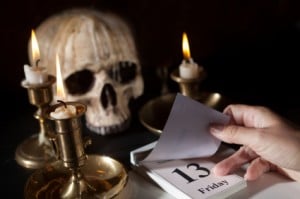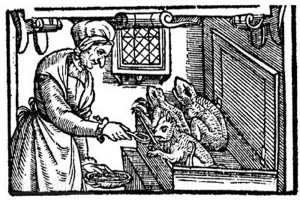 You may have noticed that it’s Friday 13th today, a day said to be ‘bad luck’ which it obviously is if you’re not the good-looking hero/heroine of a slasher movie and don’t have a contract for the next film.
You may have noticed that it’s Friday 13th today, a day said to be ‘bad luck’ which it obviously is if you’re not the good-looking hero/heroine of a slasher movie and don’t have a contract for the next film.
Now, I’m not at all superstitious and I will carry on my day as usual today, but I thought this was the ideal opportunity to look at the beliefs that Tudor and Elizabethan people held, which we would call ‘superstitions’ today.
As it says in The Cambridge History of English and American Literature, “the belief in fetishes, totems, the evil eye, luck-bones, folk-remedies, love charms and nefarious magic was rampant in England” at this time so let’s have a look at some of those superstitions, beliefs and customs:-
- Strange sights, miracles and portents were often reported – “We read of children born without arms and legs, a monstrous pig with a dolphin’s head, a child born with ruffs, and another having “the mouth slitted on the right side like a libarde’s (leopard’s) mouth, terrible to beholde” and these were taken as “the manifestations of God’s wrath and to repent”.
In his Chronicles, Raphael Holinshed writes of the year 1562: “This yeare in England were manic monstruous births. In March a mare brought Tuene foorth a foalc with one bodie and two heads, and as it were a long taile growing out betweene the two heads. Also a sow t’arowed a pig with foure legs like to the armes of a manchild with armes and fingers, etc. In Aprill a sow farrowed a pig with two bodies, eight feet, and but one head: manie calves and lambs were monstruous, some with collars of skin growing about their necks, like to the double ruffes of shirts and neckerchers then vsed. The foure and twentith of Maie, a manchild was borne at Chichester in Sussex, the head armes, and legs whereof were like to an anatomie, the breast and bellie monstruous big, from the nauill as it were a long string hanging: about the necke a great collar of flesh and skin growing like the ruffe of a shirt or neckercher, comming vp aboue the eares pleited and folded.”
- Witchcraft and sorcery – The belief in the prevalence of witchcraft and women who had enjoyed “a carnal union with the devil” and were wreaking havoc on society with their sorcery. Various acts of Parliament against sorcery were enacted in Tudor times.
- Remedies – BBC Horrible Histories lists some of the wackier remedies used by Tudor people: “Got a headache? Then rub your forehead a rope that was used to hang a criminal. Suffer from rheumatism? Then wear the skin of a donkey. In pain with gout? Boil a red-haired dog in oil, add worms and the marrow from pig bones. Rub the mixture in. A painful liver? Drink a pint of ale every morning for a week – with nine head-lice drowned in it. Are you bald? Use a shampoo made from the juice of crushed beetles. When the head is clean then rub in grease made from the fat of a dead fox. Are you a martyr to asthma? Swallow young frogs or live spiders, cover them in butter to help them slide down easier. Other crazy cures included powdered human skull, bone-marrow mixed with sweat, a stone that has killed a she-bear and fresh cream mixed with the blood of a black cat’s tail.” Don’t try any of those at home!
- Ghosts – Obviously there are many people today who believe in ghosts and I’m not questioning that belief, but most Tudors believed in ghosts and Tim Lambert writes “The dead might return to haunt the living for a number of reasons but it was believed that suicides were very likely to return as ghosts. For this reason suicides were very often buried by a crossroads with a stake through their heart. (That was believed to prevent their ghost ‘walking’)” and also explains the common superstition of ‘sin-eating’: “You passed bread and beer over a dead body to a hired sin-eater. It was believed that when he ate and drank he took the dead person’s sins on himself.”
- Sneezing – Ever wondered why your automatic response when someone sneezes is to say “Bless you”? Well, it allegedly stems from the Elizabethan era when people would say “God bless you” after someone had sneezed to protect the person from the Devil entering their open mouth.
- Lucky and unlucky things – Alyson Paige, in “Devil Superstitions of the Elizabethan Times” writes of how cats were seen as unlucky, whereas fire, silver, iron and salt were seen as being lucky.
- Charms – People could buy charms from wise men or women to ward off evil, to bring good luck, to cure illness, to prevent drunkenness, to find lost property, to get rid of vermin, to get children to sleep, to make someone fall in love with you, to determine the sex of a baby, to put out fires and all other manner of things. They were part of everyday life and not seen as evil or incompatible with religion.
- Miracles associated with religious relics and shrines – Obviously these were religious beliefs rather than superstitions.
- Prophecies – Examples: The Holy Maid of Kent, Elizabeth Barton, prophesied that Henry VIII would meet disaster if he divorced Catherine of Aragon, the book of prophecy that Anne Boleyn found in her apartments which depicted Henry, Catherine of Aragon and Anne, but the figure of Anne was missing its head, and then Mrs Amadas claiming that Henry VIII was Mouldwarp from the old prophecy and legends.
- Enchantments – The belief that illnesses and deaths could be caused by enchantments
- Omens – The belief that natural phenomena like comets and solar eclipses were omens

As you can see, the Tudor era was a very superstitious age and a time when religion, superstition and things like astrology were all mixed together in a big melting pot. Interesting times!
You can read more about this in the following articles:-
Do you have any superstitions?
Notes and Sources
- Superstition in the sixteenth century in The Progress of Social Literature in Tudor Times, The Cambridge History of English and American Literature
- BBC History – Terrible Tudors
- Holinshed’s Chronicle, Volume IV, p204
- Death and Funerals in Tudor England, Tim Lambert
- Devil Superstitions of the Elizabethan Times, Alyson Paige